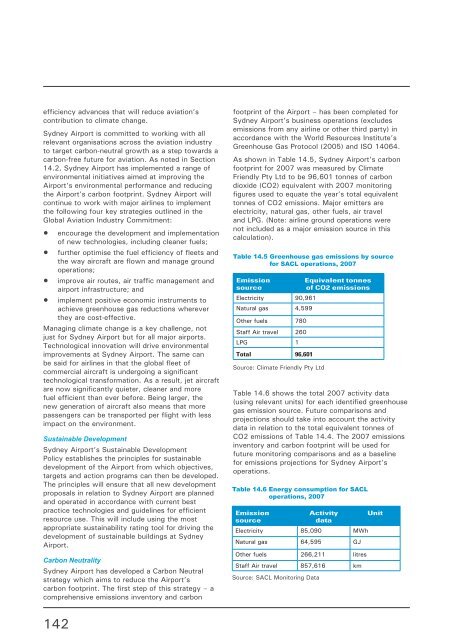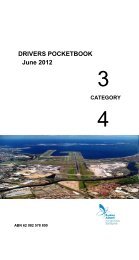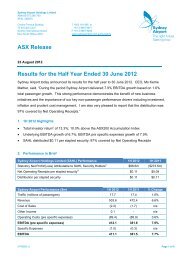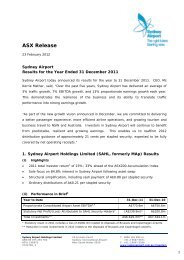Master Plan 2009 - Sydney Airport
Master Plan 2009 - Sydney Airport
Master Plan 2009 - Sydney Airport
You also want an ePaper? Increase the reach of your titles
YUMPU automatically turns print PDFs into web optimized ePapers that Google loves.
efficiency advances that will reduce aviation’s<br />
contribution to climate change.<br />
<strong>Sydney</strong> <strong>Airport</strong> is committed to working with all<br />
relevant organisations across the aviation industry<br />
to target carbon-neutral growth as a step towards a<br />
carbon-free future for aviation. As noted in Section<br />
14.2, <strong>Sydney</strong> <strong>Airport</strong> has implemented a range of<br />
environmental initiatives aimed at improving the<br />
<strong>Airport</strong>’s environmental performance and reducing<br />
the <strong>Airport</strong>’s carbon footprint. <strong>Sydney</strong> <strong>Airport</strong> will<br />
continue to work with major airlines to implement<br />
the following four key strategies outlined in the<br />
Global Aviation Industry Commitment:<br />
• encourage the development and implementation<br />
of new technologies, including cleaner fuels;<br />
• further optimise the fuel efficiency of fleets and<br />
the way aircraft are flown and manage ground<br />
operations;<br />
• improve air routes, air traffic management and<br />
airport infrastructure; and<br />
• implement positive economic instruments to<br />
achieve greenhouse gas reductions wherever<br />
they are cost-effective.<br />
Managing climate change is a key challenge, not<br />
just for <strong>Sydney</strong> <strong>Airport</strong> but for all major airports.<br />
Technological innovation will drive environmental<br />
improvements at <strong>Sydney</strong> <strong>Airport</strong>. The same can<br />
be said for airlines in that the global fleet of<br />
commercial aircraft is undergoing a significant<br />
technological transformation. As a result, jet aircraft<br />
are now significantly quieter, cleaner and more<br />
fuel efficient than ever before. Being larger, the<br />
new generation of aircraft also means that more<br />
passengers can be transported per flight with less<br />
impact on the environment.<br />
Sustainable Development<br />
<strong>Sydney</strong> <strong>Airport</strong>’s Sustainable Development<br />
Policy establishes the principles for sustainable<br />
development of the <strong>Airport</strong> from which objectives,<br />
targets and action programs can then be developed.<br />
The principles will ensure that all new development<br />
proposals in relation to <strong>Sydney</strong> <strong>Airport</strong> are planned<br />
and operated in accordance with current best<br />
practice technologies and guidelines for efficient<br />
resource use. This will include using the most<br />
appropriate sustainability rating tool for driving the<br />
development of sustainable buildings at <strong>Sydney</strong><br />
<strong>Airport</strong>.<br />
Carbon Neutrality<br />
<strong>Sydney</strong> <strong>Airport</strong> has developed a Carbon Neutral<br />
strategy which aims to reduce the <strong>Airport</strong>’s<br />
carbon footprint. The first step of this strategy – a<br />
comprehensive emissions inventory and carbon<br />
142<br />
footprint of the <strong>Airport</strong> – has been completed for<br />
<strong>Sydney</strong> <strong>Airport</strong>’s business operations (excludes<br />
emissions from any airline or other third party) in<br />
accordance with the World Resources Institute’s<br />
Greenhouse Gas Protocol (2005) and ISO 14064.<br />
As shown in Table 14.5, <strong>Sydney</strong> <strong>Airport</strong>’s carbon<br />
footprint for 2007 was measured by Climate<br />
Friendly Pty Ltd to be 96,601 tonnes of carbon<br />
dioxide (CO2) equivalent with 2007 monitoring<br />
figures used to equate the year’s total equivalent<br />
tonnes of CO2 emissions. Major emitters are<br />
electricity, natural gas, other fuels, air travel<br />
and LPG. (Note: airline ground operations were<br />
not included as a major emission source in this<br />
calculation).<br />
Table 14.5 Greenhouse gas emissions by source<br />
for SACL operations, 2007<br />
Emission<br />
source<br />
Electricity 90,961<br />
Natural gas 4,599<br />
Other fuels 780<br />
Staff Air travel 260<br />
LPG 1<br />
Total 96,601<br />
Source: Climate Friendly Pty Ltd<br />
Equivalent tonnes<br />
of CO2 emissions<br />
Table 14.6 shows the total 2007 activity data<br />
(using relevant units) for each identified greenhouse<br />
gas emission source. Future comparisons and<br />
projections should take into account the activity<br />
data in relation to the total equivalent tonnes of<br />
CO2 emissions of Table 14.4. The 2007 emissions<br />
inventory and carbon footprint will be used for<br />
future monitoring comparisons and as a baseline<br />
for emissions projections for <strong>Sydney</strong> <strong>Airport</strong>’s<br />
operations.<br />
Table 14.6 Energy consumption for SACL<br />
operations, 2007<br />
Emission<br />
source<br />
Activity<br />
data<br />
Electricity 85,090 MWh<br />
Natural gas 64,595 GJ<br />
Other fuels 266,211 litres<br />
Staff Air travel 857,616 km<br />
Source: SACL Monitoring Data<br />
unit







